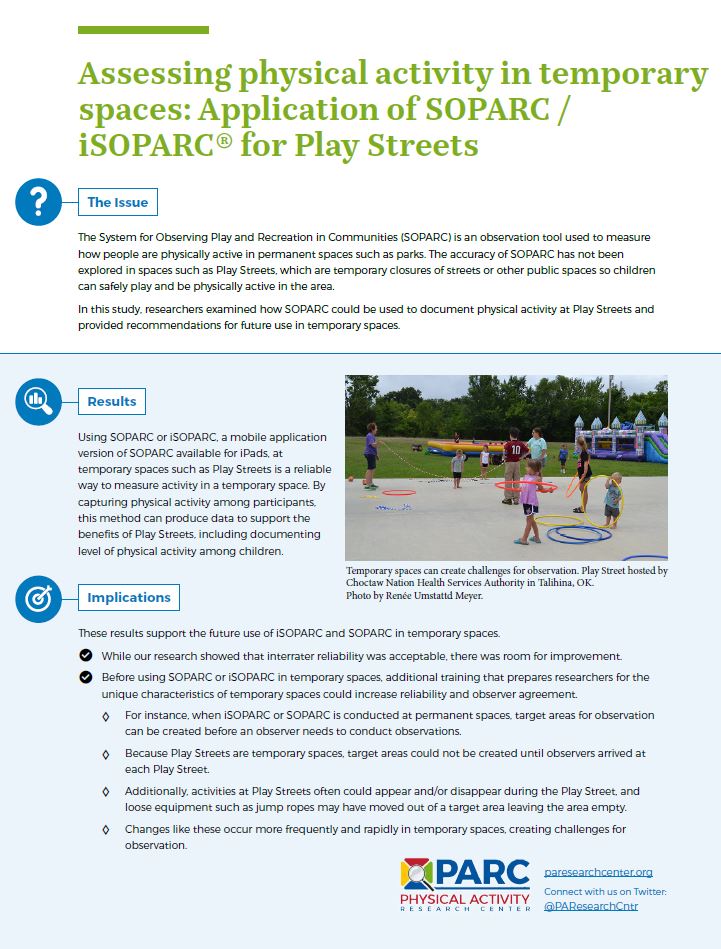Assessing physical activity in temporary spaces: Application of SOPARC/iSOPARC for Play Streets
By: M. Renée Umstattd Meyer, Tyler Prochnow, Christina N. Bridges Hamilton, Emily Wilkins, and Megan E. McClendon from Baylor University; Troy Carlton from Warner University; Thomas McKenzie from San Diego State University; and Kimberly T. Arnold and Keshia M. Pollack Porter from Johns Hopkins University
The System for Observing Play and Recreation in Communities (SOPARC) is an observation tool used to measure how people are physically active in permanent spaces such as parks. The accuracy of SOPARC has not been explored in spaces such as Play Streets, which are temporary closures of streets or other public spaces so children can safely play and be physically active in the area.
In this study, researchers examined how SOPARC could be used to document physical activity at Play Streets and provided recommendations for future use in temporary spaces.
Results
Using SOPARC or iSOPARC, a mobile application version of SOPARC available for iPads, at temporary spaces such as Play Streets is a reliable way to measure activity in a temporary space. By capturing physical activity among participants, this method can produce data to support the benefits of Play Streets, including documenting level of physical activity among children.
Implications
These results support the future use of iSOPARC and SOPARC in temporary spaces. While our research showed that inter-rater reliability was acceptable, there was room for improvement. Before using SOPARC or iSOPARC in temporary spaces, additional training that prepares researchers for the unique characteristics of temporary spaces could increase reliability and observer agreement.
- For instance, when iSOPARC or SOPARC is conducted at permanent spaces, target areas for observation can be created before an observer needs to conduct observations.
- Because Play Streets are temporary spaces, target areas could not be created until observers arrived at each Play Street.
- Additionally, activities at Play Streets often could appear and/or disappear during the Play Street, and loose equipment such as jump ropes may have moved out of a target area leaving the area empty.
- Changes like these occur more frequently and rapidly in temporary spaces, creating challenges for observation.
Findings from this lay summary are available in the full article, published in the Research Quarterly for Exercise and Sport:
Umstattd Meyer MR, Prochnow T, Bridges CN, Carlton T, Wilkins E, Arnold KT, et al. Assessing physical activity in temporary spaces: Application of SOPARC / iSOPARC for Play Streets. Research Quarterly for Exercise and Sport. 2019; https://doi.org/10.1080/02701367.2019.1656793.
Suggested Citation for Lay Summary:
Umstattd Meyer MR, Prochnow T, et al. Assessing Physical Activity in Temporary Spaces: Application of SOPARC/iSOPARC for Play Streets. A Lay Summary. San Diego, CA: Physical Activity Research Center; Waco, TX: Baylor University; and Baltimore, MD: Johns Hopkins Bloomberg School of Public Health; 2019. Available at: https://paresearchcenter.org/assessing-physical-activity-temporary-spaces-application-soparc-isoparc-play-streets/.
This lay summary was made possible with funding from the Physical Activity Research Center. The research that generated the lay summary was led by Drs. Keshia M. Pollack Porter from Johns Hopkins Bloomberg School of Public Health and M. Renée Umstattd Meyer from Baylor University.

